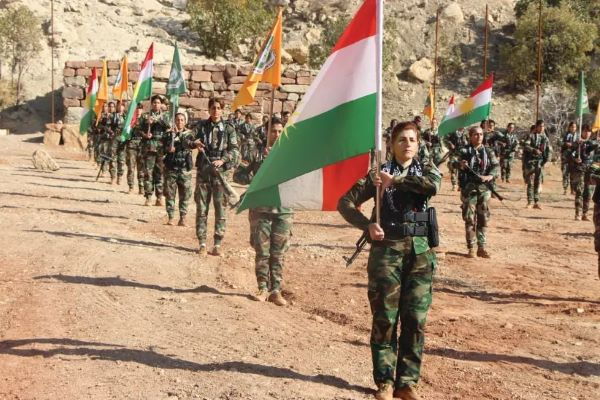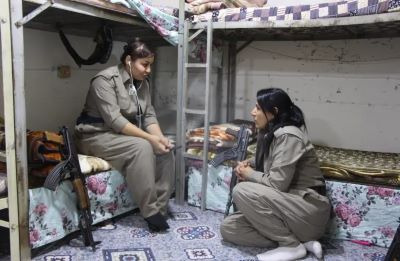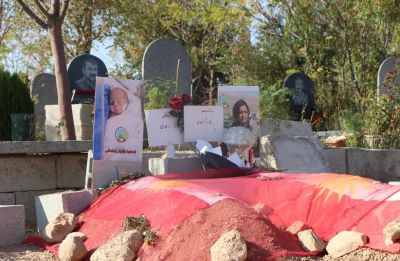by Jonathan Spyer
Our fighters fought ISIS. Like the Ukrainians, we're friends of the US, and right now we're under Iranian bombardment and are being killed.
 |
| PAK fighters at their base in Pirde, Kirkuk Province, Iraq. (Photo by Jonathan Spyer.) |
"What happened with Jina Amini was like putting a spark on a pile of TNT, which has now exploded," Hussein Yazdanpana says about the events in Iran over the past two months. "We will not accept what has happened to the Kurds. We see what happened to this girl as an insult to our dignity and our honor. And we are now taking part in the uprising against the Iranian regime." [Amini was a 22-year-old Kurdish Iranian woman who died in Tehran after having been arrested for allegedly not wearing the hijab in accordance with government standards.]
Yazdanpana is the leader of the Kurdish Freedom Party (PAK – Parti Azadi Kurdistan), one of three Iranian Kurdish organizations targeted by Tehran's missiles and drones in recent months. We are talking in a small hut located at the movement's headquarters in Pirde, Kirkuk Province, in northern Iraq, near where the missiles landed.
In mid-November, The Jerusalem Post visited all three of the targeted areas and conducted interviews with leaders and activists of the targeted organizations. We were able to meet with young Iranians who had taken part in the current protests before they were identified by the Iranian security services and fled the country.
The Iranian authorities are doing their best to block access to the country and stifle the voices of those revolting against it. Our visit provided a valuable window into events in Iran, as well as the protesters' sentiments, views and motivations.
The PAK's unambiguous rhetoric and demands, and their emphasis on military activity and struggle, are two areas that distinguish the group from the cluster of small, armed Kurdish organizations gathered along the Iraq-Iran border. For instance, the organization openly calls for the establishment of a sovereign Kurdish state on the lands that the Iranian Kurds call "Rojhelat." Other Kurdish groups tend to restrict themselves to demands for autonomy within a federal Iran or various other formulations.

Militarily, the movement is renowned for its actions both during the war against ISIS and, in particular, during the Iraqi Kurds' desperate defense against pro-Iran Shia militias after the failed Kurdish independence bid in September 2017. At the time, the movement stopped the advance of the militias toward the Iraqi Kurdish capital of Erbil, at the Alton Kopri bridge, which links Kirkuk and Erbil provinces.
Formed in 2006, the PAK, like other targeted groups, is a small organization, numbering around 1,000 fighters, with a larger network of supporters inside and outside Iran.
The base at Pirde was attacked by the Islamic Revolutionary Guards Corps (IRGC) on September 28, shortly after the outbreak of the current uprising against the regime in Tehran. Six members of the movement were killed. The bases of two other Iranian Kurdish groups, Komala and the Kurdish Democratic Party of Iran (PDKI), were also targeted; 18 people died in the attacks.
The Iranian regime accuses the PAK and the other organizations of carrying out armed attacks against regime security forces and of fomenting the current demonstrations and protests. IRGC Brig.-Gen. Muhammad Pakpour was quoted by the IRGC-associated Tasnim news agency as saying that the attacks will continue until there is a "complete disarmament of the anti-Iranian and separatist terrorist groups."
Yazdanpana and leaders of the other two organizations dismiss the accusations of "armed attacks," while admitting to active support for the uprising. "As PAK," he told me, "we are calling for the continuance and expansion of the protests. This is what we're working on. What is happening now is not criticism of the government. We are demanding the end of the regime. Iran's bombardments just motivate us more."
On the issue of armed action, the PAK leader said: "We want to continue and expand the civil way. But we should also be prepared and should not hesitate to protect ourselves."
Alongside the determination, there is a clear frustration at the failure of Western countries to respond adequately to Iranian aggression, and a more general failure to grasp the nature of the Iranian regime and its regional intentions.
"Our fighters fought ISIS. Like the Ukrainians, we're friends of the US, and right now we're under Iranian bombardment and are being killed. How can the international community keep silent? Do you remember when Hezbollah was bombing Israel? How do they come to have such weapons? It's not Hezbollah, it's Iran which is the source. You have to deal with the source of the weapons.
"We're not living in the age of empires," he continued, "but Iran is an imperial state. Iran wants to control the Sinjar mountains so as to put its missiles within range of Tel Aviv. It has bombed Saudi Arabia and the UAE. It has destroyed Yemen. So how can we keep silent?" he said.
"They have brought their militias into Iran. The Fatemiyoun, Zeinabyoun and so on [Afghan and Pakistani Shia militias], and they're using them against the demonstrators. They have permission to open fire wherever they want. Iran must be faced with force. With force, you can change it. But only in this way."
On the matter of Kurdish statehood, the PAK leader is unequivocal. "If Israel didn't have its own state, there would be another Holocaust. So having a state is the only way to guarantee the safety and sovereignty of the nation. I want a free and independent Kurdish state. But, of course, the people themselves must decide this."
Why is Iran targeting Iranian Kurdish organizations?
The PAK, PDKI and Komala (a social democratic political party from the Kurdish region of Iran) are organizations fighting the Islamist regime in Tehran and are committed to its downfall. At the same time, these are all small movements, with limited reach. Members of all three noted their active involvement in the protests.
Kawthar Fatahi, a leading activist with the Komala group, said that her movement maintains illegal hospitals. "We pay doctors to bring aid to wounded people. We pay the families of wounded people. We assist the movement a lot, but not via armed action."
Although the organizations actively support the uprising, they don't claim to be in control of, or leading, the demonstrations. Rather, the protests involve mainly very young people, many under 20 years old, and a few over 25.
Why, then, does the regime appear to be paying such disproportionate attention to the Iranian Kurdish organizations in the border area?
Many activists interviewed by the Post in the border area attribute this apparent disproportionate attention to a desire by the regime to present the civil uprising as a military insurgency. This depiction would then be the prelude to a much harsher crackdown on the protests, presented as a response to a national security threat.
"The regime want to turn it into a military battle with us. But we see that this would be in the interests of the regime, so we try to prevent that," said a PDKI official during an interview with the Post at the organization's Koya headquarters. "A military confrontation would enable them to cause mass casualties and end the demonstrations. So we are trying to educate people so as to avoid this.
"They attack us because they are feeling weak. The attacks also show the weakness of Iraqi sovereignty. Iran is trying to look strong when actually they are very weak," he added. "What's happening now is unprecedented in terms of the time it has continued. People are no longer willing to accept the regime. It's getting stronger day by day."
Conversations with protesters
On November 14, during our visit to the bases of the Iranian Kurdish organizations, Iran launched an additional missile and drone attack. The headquarters of the PDKI and Komala were targeted. Three people were killed at the PDKI base in Koya. We were at the base of the PAK in Pirde that day. As a precaution, the base was evacuated, and the fighters were deployed in the surrounding hills.
In the following tense hours, we were able to speak to a number of people who had taken part in the protests in Iran before making their way across the mountains to northern Iraq, to avoid arrest by the regime.
Mafriz, 19, from Sine, participated in the demonstrations for the first two weeks. The confrontations with the young women, who are demanding that the compulsory hijab laws be rescinded, are much worse than what is being reported.

"The regime attacked us with live bullets. People were wounded but couldn't go to a pharmacy or hospital. We had to take casualties to private houses. Men, women, even children, whole families took part in the demonstrations."
After two weeks, a surveillance camera placed outside a shop identified Mafriz. The authorities contacted her family, asking her to report to the local intelligence and security offices. At this point, she decided to leave. The PAK has a strong presence in Sine, and Mafriz's family made contact with the organization, to help her leave.
"After I was threatened [by the regime]," she told the Post. "I went to Sardasht. From there I was able to walk for three days with smugglers and then get to Iraq. I was terrified during the trip across the mountains," she recalled. "I thought the smugglers might sell me. After I came here, they sent me the number of the PAK. And I contacted them and came here."
Rezan, 25, also from Sine, was arrested during the fourth demonstration in which she participated, and was rescued by the demonstrators themselves. "Most participants in the demonstrations are 15 to 20 years old, coming from families that have been oppressed. Poor economic conditions, political instability; no one feels safe, and that makes people come out.
"The regime has become more aggressive, entering people's houses and so on, and I believe it will intensify. The regime is using shotguns, live bullets, tear gas, sticks and baton rounds. Also, the regime police and intelligence use fake ambulances to arrest people. So wounded people are being treated in their homes rather than in the hospital.
"We have to respond to the regime, bullet with bullet," she concluded, "so we need the support of the international community for this, to go back to our lands and to take revenge for all the innocent people who have been killed." When she learned where we were from, she said, "Israel should keep punishing the regime. As much as you can."
Hussein, 27, a construction worker from Saqqez, took part in the demonstrations that launched the current uprising, following Amini's death while in custody, before escaping to Iraq with his wife and young son.
"I'm a painter and decorator, an ordinary worker. We lived in poor conditions, like thousands of other young people in Iran. The events surrounding Jina's death gave us an opportunity to go to the streets, make a change, and demonstrate," he said.
"I went with four of my friends. Two of them have now been arrested and disappeared. The others were injured. I was recognized, and the authorities went to my parents' home. They took my sister's phone and called me. And when I answered, the voice told me 'Come to us, you son of a bitch.' So I got some friends to bring my family to me. And we came here."
Hussein and his family are staying with the PAK in Pirde because he fears the presence of Iranian sleeper cells in cities such as Erbil or Suleimania. The vulnerability of Iraqi Kurdistan to Iranian intelligence penetration, and the fears of Iranians present in this area, are under-reported aspects of this story.
"They killed Musa Babakhani in Erbil," Hussein reminded me when I asked whether such precautions were necessary. Babakhani, a leading activist in the PDKI, was murdered in an Erbil hotel room in August 2021 by agents of the Iranian regime.
These testimonies, gathered as we waited in the mountains for the all-clear to be given, reflect earlier conversations with activists and participants in the Iranian protests. The details matter. The issue of the abuse by the authorities of medical care, in order to apprehend demonstrators, came up again and again.
As we saw in the statements of Kawthar Fatahi of Komala, it is in this area that the Kurdish organizations are most practically engaged, creating an independent, rudimentary medical infrastructure that enables wounded participants to avoid public hospitals and the authorities.
The sexual abuse of demonstrators by authorities also came up. Though a taboo subject in Iran's conservative environment, claims surfaced in several conversations and is worthy of greater attention and investigation.
At the Komala base in Zergwez, Rojda, 22, from Saqqez, gave a vivid account of the first moments of the uprising. "When we heard that Jina had been killed and that the next day the regime was preparing to bury her, in darkness, at 4 a.m., all the people in Saqqez went down to block the streets leading to the cemeteries.
"The police came and began to push people back. The killing of Jina was so brutal. Saqqez people knew that she was a good person, who did nothing to deserve this. It was not acceptable.
"The police and intelligence tried to threaten us as the women's demonstration began to spread. The next day, the women came to the streets again, to block the road, with the men behind them. Then the police began to open fire, with shotguns.

"After four days in the demonstrations, I was providing first aid. They said I had to come to the intelligence station. Then I decided to leave, and I came across the mountains.
"I'm optimistic that the regime will fall soon, because of the anger of the people that I saw during the demonstrations. Young women, 19 and 20 ears old. Despite the threat, the fear has gone. For that reason, I'm optimistic that the regime will fall soon."
The road ahead
The latest news from Iran suggests a sharp intensification of regime tactics. Three months in, the regime has evidently decided that ongoing containment is no longer an option. Esmail Ghaani, commander of the IRGC's elite Quds Force, was in Iraq in mid-November for a two-day visit.
While there, Ghaani threatened Iraqi and Kurdish officials with an Iranian ground military operation, unless the Iranian Kurdish organizations along the border were disarmed. Ghaani's visit came a day after the November 14 attacks on Koya. Whether or not a ground incursion takes place, no one expects that the November 22 missile and suicide drone attacks on the PAK will be the last.
The first executions of protesters condemned for their participation in the demonstrations have begun. On Thursday, December 8, according to BBC News, the Iranian judiciary announced the execution of Mohsen Shekari. He had been convicted of "waging war against God" for blocking a street and wounding a member of the Basij. Eleven others arrested since the start of the uprising await execution.
So far, 458 people have been killed in the Iranian regime's response to the demonstrations, including 63 children and 29 women, according to Iranian human rights organizations. The protests continue.
Jonathan Spyer is director of research at the Middle
East Forum and director of the Middle East Center for Reporting and
Analysis.
Source: https://www.meforum.org/63907/iran-protests-inside-the-kurdish-uprising-against?goal=0_086cfd423c-fce008c1c6-33965461&mc_cid=fce008c1c6&mc_eid=c8855f5353
No comments:
Post a Comment